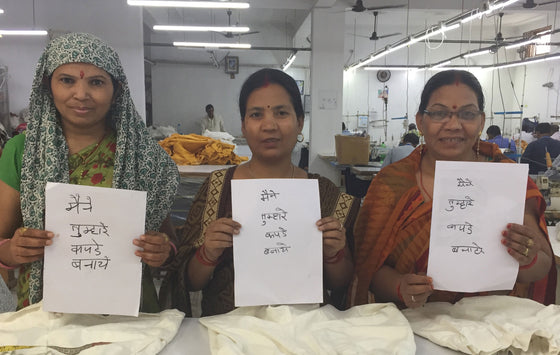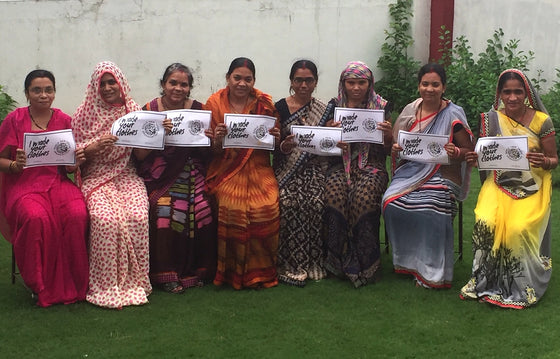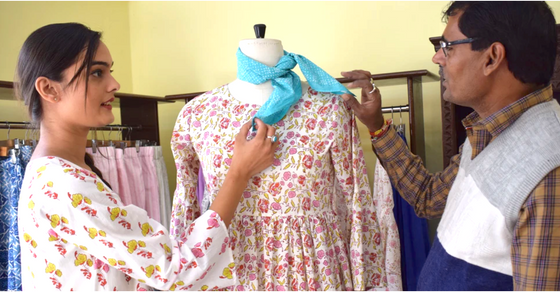Revolution is - Bridging the Gap
April 20, 2016

Years ago, before Shari and I met, I was in the silver and gem business, based here in Jaipur, in an age when there was no internet, no fax, no cell phones, and when an international call cost a fortune, sounded like an echo chamber, and usually broke off after twenty seconds. I would come to town with cash (because bank transfers were not reliable yet, and there were no ATMs), and try as best I could to spend all of it on merchandise, which I would hand carry back to the States. I had to have the goods in hand for personal checking, and could not have them safely shipped. There was really no other way to do things at that time.
Eventually, I found people I felt I might trust with my work, and who were capable of handling the (then) extremely tricky rules involved with export. There were extended periods, of course, when I waited back in the States, in high anxiety, wondering when my goods would be completed and shipped. As I mentioned, communications were difficult back then; there were lapses; things didn’t happen according to schedule. Often I would return to India angry at what I took to be irresponsibility or carelessness, only to learn that my supplier had faced tremendous , unforeseen difficulties that made everything understandable. My anger would go away, and I would feel a little ashamed at my lack of trust, and also feel gratitude for all his efforts.
Enough of these ups and downs finally made me understand that I did, in fact, trust this person. More than that, I needed to trust him. If there wasn’t trust between us, the business would not have been possible. The same was true on his side. He understood this, even before I did.
Because I trusted this individual, and he trusted me, we were able to talk frankly with each other about some of the cultural gaps between us—the signals that are often mis-read, the expectations that aren’t understood. The things that instill suspicion and doubt, where they really aren’t warranted.
I asked him one day, “When you know you can’t do something…say, get something done by the time I say I need it, why don’t you just come out and tell me? Why do I have to drag it out of you, or wait to figure it out myself?”
He looked a little embarrassed. “To us, it is rude to say ‘no’ to you like that, not respectful.”
The “not respectful” bit was because I was older than he was.
“But to me, it’s not rude or disrespectful. I appreciate it. I can’t plan if I don’t have accurate information.”
As time went by both of us became more conscious of the kinds of assumptions that led to gaps of understanding, in both directions. I saw that if I drew a rough sketch for an earring, the silversmith might present me with a finished design far removed from what I intended, but a very good approximation of some traditional design that he thought was similar to my rough sketch, and which, he naturally assumed, is what I was after. It didn’t benefit anyone for me to get upset by this; I had to learn to be precise about these things.
And I had to learn that if I put a stone above a certain size in an earring, the required silver to keep it in a setting would weigh up to a point that no one in my market would want it. Eventually, the smiths came to realize this point, and would warn me in advance. So the back and forth took time, but after awhile, it actually took.
And on it went. I came to know other people in my line, from different parts of Europe and Australia, and I noticed that the ones who were making their way toward success were the ones who were doing, basically, what I was doing: taking the time to get to know the people, and to understand the processes, and the thinking. They wanted to understand both sides of the business, not just their side. They were the ones who invested in give-and-take, in the mutuality of exchange.
Then, in 1999, Shari and I initiated the Mehera Shaw clothing line, inspired by our love for traditional textiles, Shari’s interest in clothing design, and fortified by Mark’s supposed “savvy” about doing business in India.
But as it turned out, Mark’s “savvy” proved to be worth much less than he would have supposed.
Because the apparel business is nothing like the gem and jewelry business. On the whole, the apparel industry sets up walls and screens between clients, suppliers, and artisans. Personal relationships don’t count for much in an industry where agreements are frequently, and often shamelessly, broken, and where many relationships are fundamentally adversarial, regardless of the surface gloss.
Somehow we survived, but at what cost? And the problem wasn’t just on the supply end; it was equally hazardous on the market side, as we quickly discovered that New York is often more treacherous than New Delhi.
Finally, it became clear to us that we had to start our own production company, not only for our own label, but for others who were floundering around like us, trying to bring their ideas to fulfillment and for the sake of working in a way we could believe in.
We would be the company we couldn’t get anybody else to be.
In 2007, accompanied by our three small children, we founded Mehera Shaw Textiles, Pvt. Ltd., as a Jaipur based small garment manufacturer. And in short order it felt as though someone had picked us up and thrown us over a high wall, and when we landed we found ourselves lock, stock, and barrel on the India artisan side of the equation. We had started as clients; now we were suppliers. We had started out giving orders; now we were taking them. The people who had been working for us were now working beside us. We had spent years scrutinizing suppliers’ failures to communicate intelligibly; now we were faced with clients who didn’t communicate intelligibly and faced with learning how to communicate clearly to clients. We had been charitable, we thought, when we were understanding about suppliers’ failures; now we identified with those failures, because we were directly involved with keeping them from happening.
Just now I used the image of being thrown over a wall, but I could just as well have said that we suddenly found ourselves sitting on a fence, because once we began to climb back up that is where we ended. We were now not on one side or the other, neither simply client or supplier, but both. We are on both sides of the face at the same time: we are faced with bridging the gap in understanding between supplier and customer, east and west, traditional and modern.
We discovered that ‘doing things right’ meant we had a lot to learn and we’ve learned it from the people we work with.
We began to learn things we never thought we’d have to know, and much of this knowledge was hard won and cost us a lot of sleepless nights. But at the same time we forged bonds with people we deeply respect; we saw, in such cases, that “Honor” still has meaning. We met creative, humane individuals who are trying to make the world a better place through their work. We have known people who labor in humble, difficult conditions, who have inspired us with their grace and dignity.
This dual perspective, this being in two worlds, being client and supplier, is going to inform the coming series of articles. We’re going to explore a lot of issues, things having to do with culture and assumptions, communication and hard realities, craft and expectation, definitions and standards.
It’s been quite a ride up to now, and we’re looking forward to sharing some of it with you.
Leave a comment
Comments will be approved before showing up.








